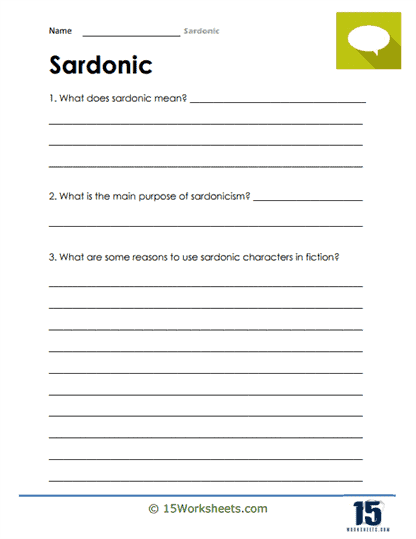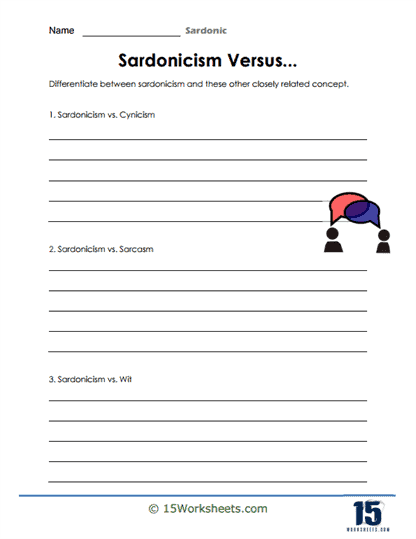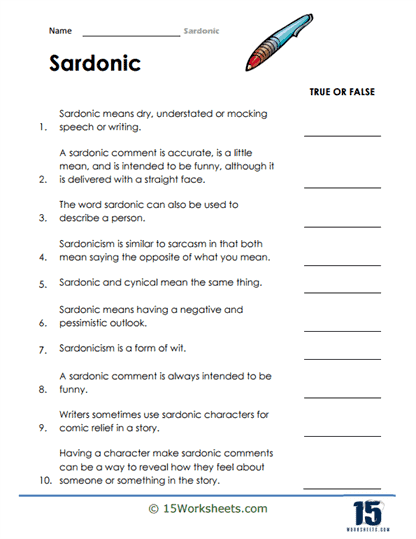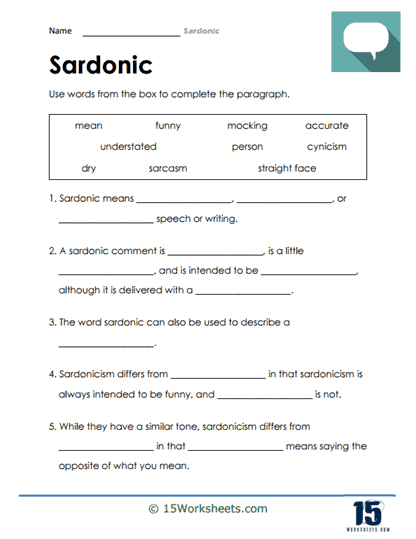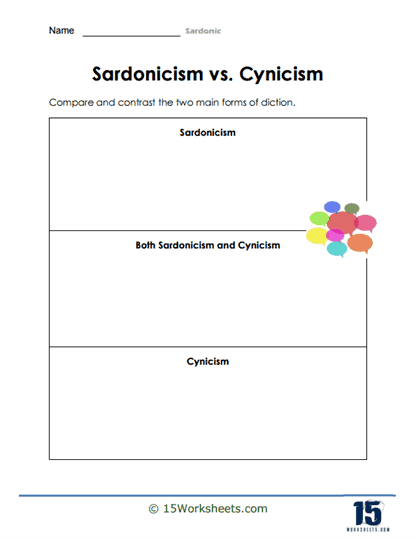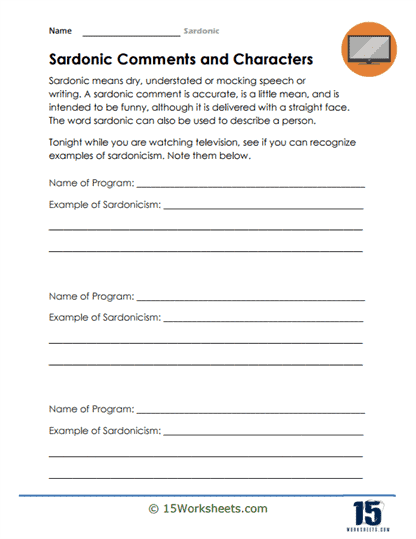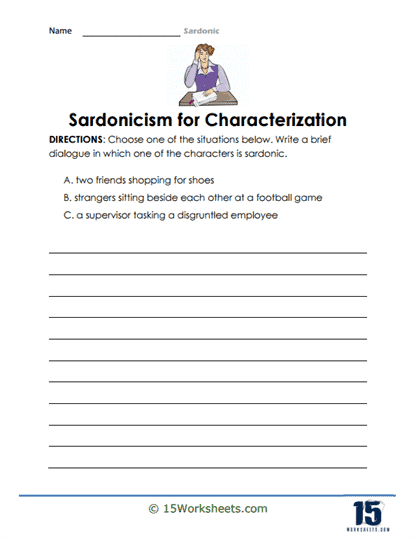Sardonic Worksheets
About These 15 Worksheets
These worksheets were developed to infuse humor and irony into language arts and reading comprehension exercises. These worksheets provide a unique approach to engage students while deepening their understanding of literary devices, societal critique, and language nuances. In this comprehensive exploration, we will delve into the various types of exercises found on sardonic worksheets and elucidate how practicing with them can elevate students’ language arts proficiency and reading comprehension skills.
Sardonic worksheets are crafted to incorporate elements of sarcasm, irony, and satire into learning materials. They aim to challenge students to think critically, analyze texts, and develop a discerning literary sensibility. These worksheets often feature a range of exercises tailored to different aspects of language arts and reading comprehension.
Through a variety of exercises ranging from analyzing satirical texts to crafting original satire, students develop critical thinking skills, literary analysis proficiency, and creative expression abilities. By practicing with sardonic worksheets, students not only improve their language arts and reading skills but also cultivate a deeper appreciation for the power of humor and satire to provoke thought, challenge assumptions, and inspire change.
Analyzing Satirical Texts
One prominent exercise found on sardonic worksheets involves analyzing satirical texts. Students are presented with excerpts from satirical literature, such as essays, short stories, or plays, and are tasked with identifying instances of irony, sarcasm, or social commentary. Through close reading and annotation, students decipher the underlying messages and explore how authors use humor to critique societal norms, human behavior, or institutions.
For example, students might analyze Jonathan Swift’s “A Modest Proposal,” a satirical essay that suggests solving poverty in Ireland by advocating for the consumption of infants. Through guided questions and prompts, students unravel the layers of irony and satire embedded in the text, gaining insights into Swift’s scathing critique of English colonialism and economic exploitation.
Creating Satirical Writing
Another exercise encourages students to flex their creative muscles by crafting their own satirical pieces. Whether it’s composing satirical essays, parodying advertisements, or writing satirical news articles, this exercise challenges students to employ irony and wit to convey a critical message or poke fun at societal conventions.
For instance, students might write a satirical news article addressing a contemporary issue, such as climate change denial or political polarization. By adopting a satirical tone and employing hyperbole or absurdity, students not only hone their writing skills but also deepen their understanding of the power of satire to provoke thought and incite change.
Interpreting Political Cartoons
Sardonic worksheets often include exercises centered around interpreting political cartoons, a form of visual satire. Students analyze cartoons depicting current events, political figures, or social issues, discerning the symbols, caricatures, and captions employed by cartoonists to convey a satirical message.
Through guided discussions and analysis prompts, students decode the underlying commentary within the cartoons and explore how visual elements enhance the satirical impact. This exercise cultivates visual literacy skills and fosters a deeper appreciation for the multifaceted nature of satire.
Exploring Humorous Literature
In addition to satire, sardonic worksheets may feature exercises focused on exploring humorous literature. From witty dialogue in comedic plays to clever wordplay in humorous essays, students engage with texts that employ humor as a literary device.
For example, students might study Oscar Wilde’s “The Importance of Being Earnest,” a comedy of manners that satirizes Victorian society’s obsession with superficiality and social conventions. By dissecting Wilde’s clever dialogue and farcical plot twists, students not only appreciate the comedic elements of the text but also gain insights into the underlying social commentary.
Debating Controversial Topics
Sardonic worksheets also incorporate exercises that stimulate critical thinking and encourage lively debate. Students engage in discussions or written reflections on controversial topics, exploring opposing viewpoints and evaluating the use of irony or sarcasm in argumentation.
For instance, students might debate the merits of censorship in literature, considering both sides of the argument while dissecting satirical texts that critique censorship or authoritarianism. Through structured debates or persuasive writing assignments, students develop analytical skills and learn to construct compelling arguments while navigating complex moral and ethical dilemmas.
The Benefits Of These Worksheets
Practicing with sardonic worksheets offers numerous benefits for students, enhancing their language arts proficiency and reading comprehension skills in various ways:
Critical Thinking Skills – Analyzing satirical texts and crafting satirical writing prompts students to think critically about language, rhetoric, and underlying messages. By dissecting layers of irony and satire, students develop discernment and learn to question societal norms and assumptions.
Engaging with satirical literature deepens students’ understanding of literary devices and techniques. Through close reading and textual analysis, students hone their ability to identify irony, sarcasm, and satire, fostering a more nuanced interpretation of literary texts.
Creative Expression
Writing satirical pieces encourages students to explore their creativity and develop their unique voice. By experimenting with humor and satire, students refine their writing skills and learn to effectively communicate complex ideas in an engaging and entertaining manner.
Interpreting political cartoons and debating controversial topics foster empathy and perspective-taking skills. Students learn to consider multiple viewpoints, appreciate diverse perspectives, and recognize the power of satire to challenge prevailing attitudes and beliefs.
Engagement and Motivation
The humor and wit inherent in sardonic worksheets captivate students’ interest and motivation, making learning enjoyable and rewarding. By incorporating elements of entertainment into educational materials, sardonic worksheets inspire curiosity and foster a lifelong love of learning.
What is the Literary Device of Sardonic?
Sardonicism is a distinctive form of wit, characterized by its scornful, mocking, and often cynically humorous tone. Unlike mere sarcasm or irony, which can be wielded with a light touch or even affection, sardonic expressions carry a darker, more contemptuous edge. They suggest a disdain that goes beyond playful teasing, often pointing to deeper insights or critiques of human behavior and societal norms. This literary device allows authors to engage with their subjects on a profound level, exposing flaws, hypocrisies, and absurdities through a lens of sharp, unsparing humor.
Defining Features of Sardonic
The main defining feature of sardonic humor is its bitter, cynical edge. It is humor that comes not from amusement but from disillusionment or skepticism about the human condition. Sardonic wit is often directed at overarching societal issues, human vices, or individual folly, and it carries a tone of superiority from the speaker or author, who appears to stand apart from the follies they mock. This detachment enables the sardonic voice to comment on events, behaviors, or norms with a penetrating clarity that is both humorous and cutting.
Characteristics of Sardonic
Cynicism and Skepticism – Sardonic humor is deeply rooted in a cynical view of the world. It reflects a skepticism about human nature, institutions, and the likelihood of positive change.
Mockery and Contempt – Unlike more benign forms of humor, sardonicism often involves a level of mockery or contempt. It doesn’t just laugh with its subjects; it laughs at them, highlighting their inadequacies or the absurdity of their actions.
Intellectual Wit – Sardonic humor is intellectually engaging, requiring a level of insight from both the creator and the audience. It is often used in literary and sophisticated contexts.
Subtlety and Sophistication – While sardonic remarks can be overt, they often rely on subtlety and sophistication, requiring a discerning audience to fully appreciate their depth.
Dark Humor – Sardonicism frequently intersects with dark humor, finding comedic elements in topics that are generally considered serious or taboo.
Examples of Sardonicism in Literature
“Gulliver’s Travels” by Jonathan Swift
In this satirical novel, Swift uses sardonic humor to critique human nature and society. The descriptions of the petty squabbles among the Lilliputians, which parody the absurdity of European politics, are delivered in a sardonic tone that underscores the triviality and vanity of human conflicts. Swift’s portrayal of the Houyhnhnms, rational horses who consider humans (Yahoos) to be utterly depraved, further employs sardonic wit to expose the folly and hubris of mankind.
“Candide” by Voltaire
Voltaire’s use of sardonic wit is evident in “Candide,” particularly in the treatment of the philosophy of optimism. Through a series of increasingly unfortunate and absurd events, Voltaire mocks the idea that “all is for the best in the best of all possible worlds.” His sardonic tone highlights the disconnect between philosophical idealism and the harsh realities of the world, encouraging readers to question the validity of such optimistic philosophies.
“Catch-22” by Joseph Heller
Heller’s novel is renowned for its sardonic depiction of the absurdity of war and bureaucracy. The term “Catch-22” itself has become synonymous with nonsensical no-win situations. Heller employs sardonic humor through his portrayal of characters who are trapped in illogical and irrational systems, emphasizing the madness of their circumstances and the indifference of those in power.
Effect of Sardonicism on the Reader
The effect of sardonicism on the reader is multifaceted. It can provoke laughter, but it is laughter tinged with unease or recognition of underlying truths. Sardonic humor forces readers to confront uncomfortable realities, often leading them to question accepted norms and beliefs. It can foster a sense of solidarity in shared skepticism or disillusionment, but it can also alienate those who feel targeted by its bite. Ultimately, sardonicism enriches the reading experience by adding layers of meaning and engagement, inviting readers to look beyond the surface and appreciate the complexities of the human condition.


